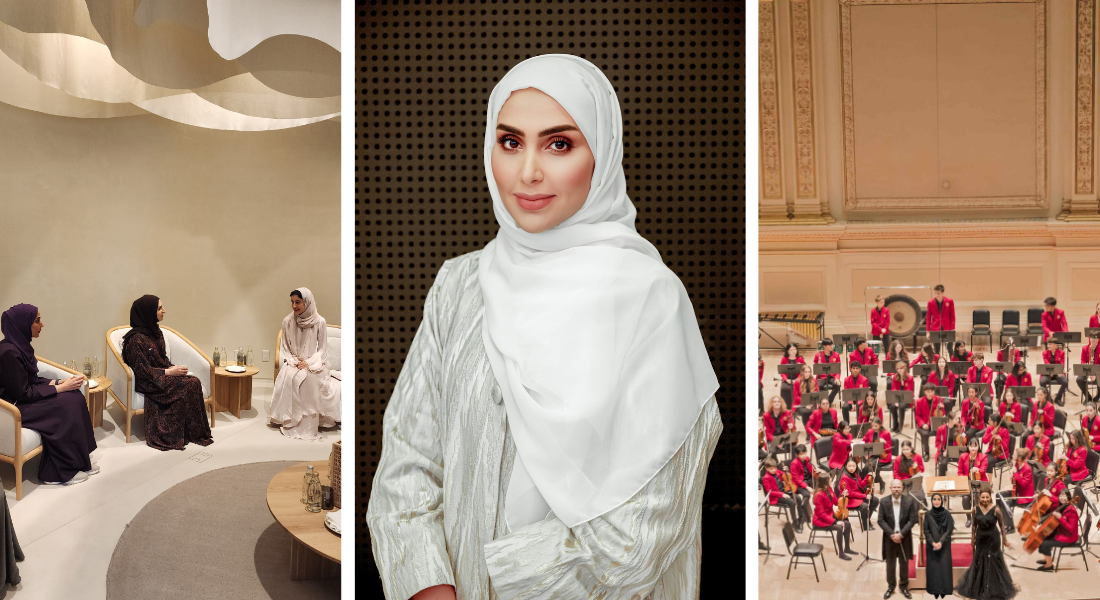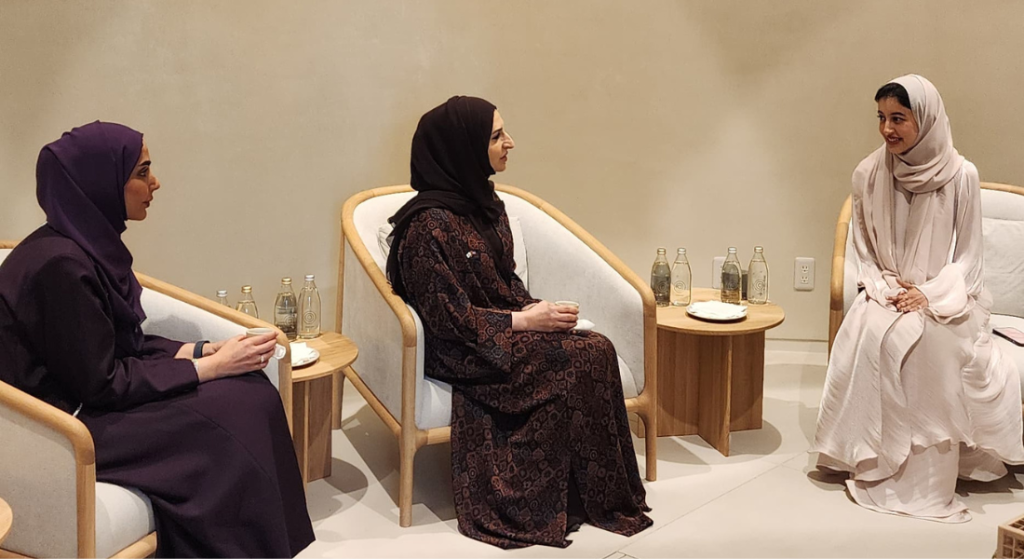
With a love of both art and storytelling, Shaima Rashed Al Suwaidi can be considered the vanguard of Dubai’s creative movement. As CEO of the Arts, Design & Literature Sector at Dubai Culture, she brings her personal passion and strategic vision to every project she leads. From the historic alleyways of Al Shindagha to the shores of Jumeirah Beach, her work bridges tradition and innovation, ensuring that Dubai’s evolving identity remains rooted in authenticity.
Under her leadership, Dubai Culture has amplified its presence on the global stage through landmark initiatives such as Pillars of Arish: Architecture in Transition, a curated symposium at Expo 2025 Osaka that explored the future of sustainable design rooted in heritage.
Likewise, the Authority’s support of NYO–Dubai’s historic performance at Carnegie Hall spotlighted the UAE’s rising creative talent, reaffirming Dubai’s cultural diplomacy efforts.
Whether nurturing grassroots talent or driving international collaborations, Shaima continues to shape a creative ecosystem that positions Dubai as a global centre for culture.
From a young age, I was fascinated by how art and storytelling influence the way we see ourselves and relate to others. Growing up in Dubai, I watched the city change year after year. Each new building and every event, whether it was a family celebration, a public festival, or an exhibition, added depth to our shared culture.
Since stepping into my role at Dubai Culture, I’ve seen firsthand how the right communication can bring attention to artists and encourage new audiences to engage with the arts. It’s been rewarding to see our efforts recognised and to help tell Dubai’s story on a larger stage. Each project is a chance to support creative talent and show the world what makes our city so unique.
In a place like Dubai, tradition and modern creativity go hand in hand. A lot of our most interesting cultural work happens when people use their heritage as a starting point. Take the Sikka Art & Design Festival, for example – it’s set in the Al Shindagha Historic Neighbourhood, with its narrow alleyways, wind towers, and a strong connection to the city’s past.
But every year, the artists who show up bring something new. You’ll see installations that use traditional materials, or projects inspired by traditional Emirati handicrafts but presented in ways that feel very current. You can feel this blend at the Emirates Airline Festival of Literature as well, where we invite writers from all over the world to sit alongside Emirati poets and authors.

Honestly, I don’t think learning ever really stops. Even after finishing my studies, I’ve found that the world keeps changing, and if you don’t keep upskilling, it’s easy to fall behind. I’m often surprised by how much I gain just by stepping into new situations or by admitting when I don’t know something and asking for help.
I try to remind women around me that it’s perfectly okay not to have all the answers. Finding a mentor who is willing to give you feedback or simply listen can make all the difference. Most of the confidence I have now was built slowly, one small step at a time, by trying things, messing up here and there, and adapting as I went.
If there’s one thing I really believe, it’s that we get further when we share what we know. Helping each other out or passing along a lesson means nobody’s starting from scratch.
I’m proud of what we’ve achieved with campaigns like Ramadan Heroes, which has been recognised globally. Watching that initiative grow from an idea into something that brings together volunteers, businesses, and families has been genuinely meaningful. It’s the same with our work to put Dubai’s creative scene on the global map, whether it’s through public art projects, international festivals, or supporting local talent as they make their mark abroad.
But honestly, the most rewarding moments are always the small, real ones. It might be a message from an artist who felt included or supported because of our initiatives, or the excitement that comes from seeing a project take flight once it’s given room to grow. Those are the things that keep me invested, because I like seeing my contributions translate into impact. If our work helps someone find their community or express themselves, that’s when I know it’s made a difference.

I take that responsibility seriously because I remember how powerful it was to see women leading when I was younger. It changes what you believe is possible. I want to create spaces where others feel free to experiment, to fail, and to find their voices without having to fit someone else’s expectations.
If I can share lessons from my own journey, especially the challenges or times when things didn’t go as planned, I hope it makes the path easier, or at least a little less lonely, for the next generation.
I’ve been fortunate to build my career in an environment that genuinely supports women. Within Dubai Culture, we’re helping shape policy, designing spaces, and guiding the direction of the cultural and creative sector itself. And it starts right at the top with our Chairperson, Her Highness Sheikha Latifa bint Mohammed bin Rashid Al Maktoum, and our Director General, Her Excellency Hala Badri. Today, women hold over 60 per cent of positions across the Authority.
On a national scale, initiatives like the UAE Gender Balance Council have set the tone for what’s possible. You can see the results, not just in policy, but in the teams we work with and the projects that come to life. I’m proud to be part of this change and to see more women shaping the future of our community.
The best narratives are the ones that feel honest, where you can sense the real voices behind them. That’s something I try to keep at the heart of everything we do. I spend a lot of time listening to artists talking about what inspires them, or community members sharing their own histories. It’s their perspectives that shape how we tell Dubai’s story, not the other way around.
You see this reflected in our use of public spaces. For example, the installation Resonance at Al Shindagha is shaped by the rhythms of Dubai Creek, turning the historic neighbourhood into a multi-sensory encounter with the city’s past and present. In Al Hudaiba Park, the Union of Artists served as a symbol of national unity, drawing on creative contributions from across the emirates. Meanwhile, Al Duroor invited visitors to rediscover regional traditions by blending astronomy with public art.
Participation is just as important to us. With programmes like School of Life, workshops and activities happen across libraries, museums, and heritage sites, so everyone has a way to get involved. Whether someone is trying something new or talking about their own experiences, these moments help build genuine connections and keep the community engaged.
Bringing in international artists and cultural leaders adds another dimension. Hosting summits and collaborative projects in heritage settings introduces new viewpoints, while still honouring what makes Dubai unique. Ultimately, this blend of open dialogue, initiatives that reflect the spirit of our city, and global exchange is what keeps our approach fresh and authentic.
Dubai is home to over 190 nationalities, so involving everyone isn’t just important; it’s essential. When we organise a public art trail in Al Quoz or a beach activation along Jumeirah, the most memorable moments come from seeing how residents make these spaces their own.
I’ve watched families from different countries leave their mark at community mural events, or visitors discover a sculpture and end up talking with the artist, sharing what the work means to them.
One of the things I’m proudest of is how our initiatives, like the Sikka Art & Design Festival or the Public Art Strategy, deliberately create space for this exchange. We don’t just showcase Emirati voices. We also invite artists, writers, and musicians from dozens of backgrounds to take part. Even our School of Life programme, which offers workshops in public libraries and heritage centres, draws in people who might not have had a chance to join these conversations before.
The truth is that Dubai’s story isn’t written by any one group. It’s shaped by the mix, by individuals bringing different ideas, memories, and creative traditions into the same space. That’s what gives the city its energy, and it’s why our cultural identity feels real to people from so many walks of life.
When I need inspiration, I look to my son. He’s on the autism spectrum, and he has a remarkable way of noticing details that most people overlook. He might stop to watch how the shadows shift across a wall or become completely absorbed in the colours of a sunset. Moments like these remind me to slow down and actually pay attention to the world as it is, rather than how I expect it to be.
His perspective often pulls me out of routine and encourages me to see ordinary days with fresh eyes. It helps me remember why I do the work I do – to notice what’s real and meaningful and to help others see it, too.
That sense of wonder and openness is something I try to carry with me, both in my professional life and at home, and I hope it comes through in the projects I’m part of.
